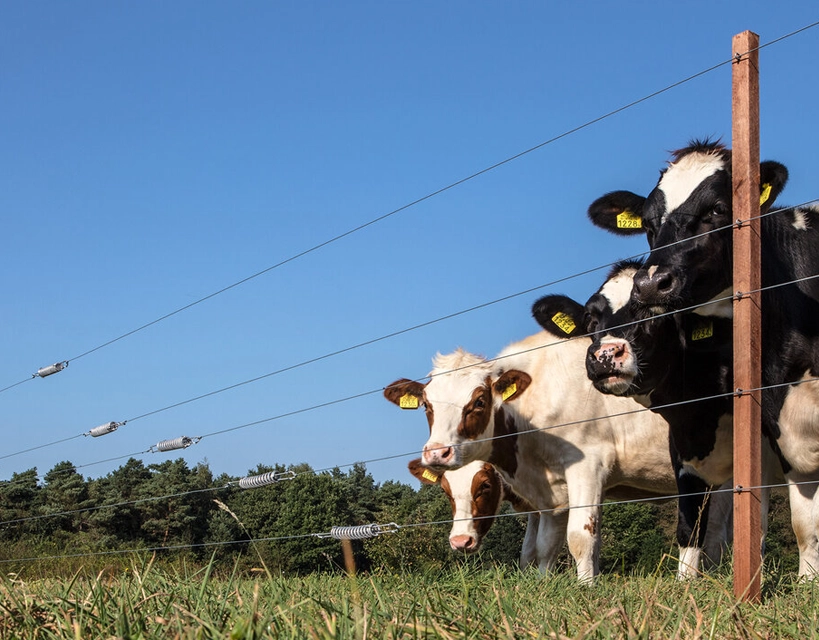Cattle Conductor Buyer's Guide
|
Conductors for Cattle
|
Fence Type: Depending on whether you want to install a permanent fixed fence or a portable mobile fence, different materials are recommended. polywire, ropes, and narrow tape (10–20 mm) are ideal for mobile fences. These are quick to set up and can easily be rolled up again. For even greater convenience during installation, we recommend using electric fence reels.
Leaning and Pushing: Cattle can lean or rub against fences, especially when they are grazing or using the fence as a scratching post. As a result, cattle fences need to be stronger and more robust than those for animals like sheep or goats, which are smaller and less forceful.
Fewer wires:In contrast to fences for goats or sheep, which require multiple wires spaced closely together, electric fences for cattle generally need only 3-4 strands. These wires can be spaced farther apart, starting at about 18-24 inches (45-60 cm) from the ground for the bottom wire and progressing upward.
Fence tension:Proper tensioning of the wires is critical for cattle fences. Loose wires can lead to cattle pushing through the fence, while tightly strung wires will keep the animals at bay.
Our Recommendations for Cattle Fences
Wire (High Tensile): High Tensile wire is our top recommendation for permanent fixed fences. This specialised steel wire is coated with a zinc-aluminium alloy, making it highly conductive and corrosion-resistant. The aluminium coating around the wire core offers excellent conductivity—up to 15 times higher than standard wire. The tensile strength is particularly high, reaching up to 220 kg. When used with steel tension springs and fence strainers, the High Tensile wire can be tightened sufficiently to allow post spacings of up to 20 m. We recommend High Tensile wire for permanent pasture fences. Its slightly higher initial cost is offset by its excellent conductivity and long lifespan.
Polywire: Polywire consists of a fine weave of conductive metal wires (stainless steel and/or copper) and non-conductive plastic threads (PE or PP). This makes them both effective and durable, suitable for mobile and permanent fences. They are more affordable than ropes, though they tend to have a slightly shorter lifespan.
Rope (Cord): Electric fence rope is one of the most popular conductor materials for cattle fences. Due to its properties, it’s ideal for mobile fencing systems for dairy cows, cattle, and bulls. The conductive wires made of stainless steel and copper are interwoven with durable plastic fibres, creating a smooth, visible rope. This rope ensures high conductivity due to the way the conductors are interwoven. The material does not stretch and is highly durable, with stainless steel conductors offering excellent flexibility and copper conductors providing high conductivity. It is easy to install and can be rolled up with a reel when not in use.
Tape: Electric fence tape is rarely used for cattle fencing. However, if you decide to use it, a width of 10–20 mm is sufficient. It is ideal for mobile fences as it can be easily rolled up on a reel when no longer needed. The tapes are made of conductive stainless steel and copper wires woven with plastic fibres. The stainless steel conductors ensure high durability, while copper conductors ensure good conductivity. Cattle can easily see the material, reducing the risk of injury. Tape is available in colours such as white, green, and terra, with contrast stripes to enhance visibility.


Avoid Using Barbed Wire!
We strongly advise against using barbed wire for cattle fencing. Barbed wire can cause serious injuries if cattle attempt to push through or escape the fence. Injuries are most likely to affect the eyes, udders, and limbs.
Our recommendations are designed to help you choose the right materials for your cows, calves, and bulls. If you have any further questions or require individual advice, feel free to contact us. Our conductor material advisor can guide you through selecting the most suitable products for your cattle in just a few steps.
For more information on how to attach conductor materials to fence posts, refer to our article on electric fence insulators for cattle.
Our manufacturers for high-quality conductor material:
- Gallagher, e.g., for high tensile wire, strands, ropes, and tape
- Pulsara, e.g., for affordable ropes and tape
|
Select your conductor material in just 3 steps
Coming Soon If you have any questions or would like personalised advice, we are happy to assist you.
|
